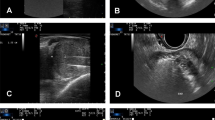Abstract
Background
In our study, we aimed to test the efficacy and safety of Trans-Perineal Laser Ablation of the prostate (TPLA®) in the surgical treatment of high-risk Benign Prostatic Obstruction (BPO) patients.
Methods
We defined a high-risk BPO patient as an elderly man affected by severe comorbidities, among which coagulation issues due to pre-existent medications or diseases. From October 2020 to June 2022, we prospectively enrolled high-risk patients affected by a moderate to severe and/or complicated BPO condition. The analysis of the efficacy of the Trans-Perineal Laser Ablation was defined as the primary endpoint of the study. Secondary endpoints were post-operative surgical complications and patient-reported quality of life.
Results
Globally, 40 consecutive patients were enrolled. Median (IQR) age was 80 (72.5–84) years. Median Charlson Comorbidity Index was 6 (5–7). Median prostate volume was 38 (30.5–73) cc. In all cases, a TPLA® procedure was performed under local anesthesia, and patients being discharged within the same day of the procedure. A progressive reduction of median prostate volumes was reported at 3 and 6 months post-operatively, compared to baseline [38 (30.5–73) vs 35 (26–49) vs 34 (28–49) cc, p < 0.001]. Median International Prostate Symptom Score (IPSS) improved accordingly [25 (19–30) vs 10.5 (7.5–13) vs 8 (6–11.5), p < 0.001]. A permanent bladder catheter was successfully removed in 13 out of 23 (56.5%) cases. Within 90 days from surgery, 19 (47.5%) patients experienced at least one surgical complication. According to the Clavien-Dindo classification, complications were classified as grade I in 16 (40%) cases, grade II in 9 (22.5%), and grade III in 1 (2.5%). We did not observe any grade IV or V complications.
Conclusions
The Trans-Perineal Laser Ablation of the Prostate is a feasible, safe, and effective Minimally Invasive Surgical Technique, when offered to elderly, high-risk patients affected by severe Benign Prostatic Obstruction.
This is a preview of subscription content, access via your institution
Access options
Subscribe to this journal
Receive 4 print issues and online access
$259.00 per year
only $64.75 per issue
Buy this article
- Purchase on Springer Link
- Instant access to full article PDF
Prices may be subject to local taxes which are calculated during checkout

Similar content being viewed by others
Data availability
The datasets generated during and/or analysed during the current study are not publicly available due to patients’ privacy protection policy, but are available from the corresponding author on reasonable request.
References
Manfredi C, Arcaniolo D, Spatafora P, Crocerossa F, Fusco F, Verze P, et al. Emerging minimally invasive transurethral treatments for benign prostatic hyperplasia: a systematic review with meta-analysis of functional outcomes and description of complications. Minerva Urol Nephrol. 2022;74:389–99.
Roehrborn CG, Issa MM, Bruskewitz RC, Naslund MJ, Oesterling JE, Perez-marrero R, et al. Transurethral needle ablation for prostatic hyperplasia: 12-Month results of a prospective, multicenter US study. Urology. 1998;51:415–21.
McNicholas TA, Steger AC, Bown SG. Interstitial laser coagulation of the prostate. An experimental study. Br J Urol. 1993;71:439–44.
Nguyen D-D, Li T, Ferreira R, Baker Berjaoui M, Nguyen A-LV, Chughtai B, et al. Ablative minimally invasive surgical therapies for benign prostatic hyperplasia: a review of Aquablation, Rezum, and transperineal laser prostate ablation. Prostate Cancer Prostatic Dis (2023). https://www.nature.com/articles/s41391-023-00669-z.
Bertolo R, Iacovelli V, Cipriani C, Carilli M, Vittori M, Antonucci M, et al. Ejaculatory function following transperineal laser ablation vs TURP for benign prostatic obstruction: a randomized trial. BJU Int. 2023;132:100–8.
Cindolo L, Campobasso D, Conti E, Uricchio F, Franzoso F, Maruzzi D, et al. Do patients treated with water vapor therapy and meeting randomized clinical trial criteria have better urinary and sexual outcomes than an unselected cohort. J Endourol. 2023;37:323–9.
Ahn S-T, Lee D-H, Cho S-B, Lee H-S, Han D-E, Park T-Y, et al. Is prostate urethral lift effective in patients with multiple comorbidities? J Clin Med. 2022;11:1928.
Tadrist A, Baboudjian M, Bah MB, Alegorides C, Bottet F, Arroua F, et al. Water vapor thermal therapy for indwelling urinary catheter removal in frail patients. Int Urol Nephrol. 2023;55:249–53.
Cornu JN, Gacci M, Hashim H, Herrmann TRW, Malde S, Netsch C, et al. EAU: Guidelines on Male Lower Urinary Tract Symptoms (LUTS), including Benign Prostatic Obstruction (BPO). Eur Assoc Urol (2023).
Dindo D, Demartines N, Clavien P-A. Classification of surgical complications: a new proposal with evaluation in a cohort of 6336 patients and results of a survey. Ann Surg. 2004;240:205–13.
Lebdai S, Chevrot A, Doizi S, Pradere B, Delongchamps NB, Benchikh A, et al. Do patients have to choose between ejaculation and miction? A systematic review about ejaculation preservation technics for benign prostatic obstruction surgical treatment. World J Urol. 2019;37:299–308.
Sokolakis I, Pyrgidis N, Russo GI, Sountoulides P, Hatzichristodoulou G. Preserving ejaculation: a guide through the landscape of interventional and surgical options for benign prostatic obstruction. Eur Urol Focus. 2022;8:380–3.
Huang J, Chan C-K, Yee S, Deng Y, Bai Y, Chan SC, et al. Global burden and temporal trends of lower urinary tract symptoms: a systematic review and meta-analysis. Prostate Cancer Prostatic Dis. 2023;26:421–8.
Marra G, Sturch P, Oderda M, Tabatabaei S, Muir G, Gontero P. Systematic review of lower urinary tract symptoms/benign prostatic hyperplasia surgical treatments on men’s ejaculatory function: time for a bespoke approach? Int J Urol. 2016;23:22–35.
Sibona M, Destefanis P, Vercelli E, Secco S, Gontero P, Cindolo L. Ejaculation physiology and dysfunction after BPH surgery: the role of the new MISTs. Prostate Cancer Prostatic Dis. 2023;26:475–82.
Cacciamani GE, Cuhna F, Tafuri A, Shakir A, Cocci A, Gill K, et al. Anterograde ejaculation preservation after endoscopic treatments in patients with bladder outlet obstruction: Systematic review and pooled-analysis of randomized clinical trials. Minerva Urol Nefrol. 2019;71:427–34.
Campobasso D, Siena G, Chiodini P, Conti E, Franzoso F, Maruzzi D, et al. Composite urinary and sexual outcomes after Rezum: an analysis of predictive factors from an Italian multi-centric study. Prostate Cancer Prostatic Dis. 2023;26:410–4.
Woo HH, Huang CP, Huang WJ, Chang YH, Lien CS, Chkhotua A, et al. The EXPANDER-1 trial: introduction of the novel UrocrossTM Expander System for treatment of lower urinary tract symptoms (LUTS) secondary to benign prostatic hyperplasia (BPH). Prostate Cancer Prostatic Dis. 2022;25:576–82.
Kaplan SA, Pichardo M, Rijo E, Espino G, Lay RR, Estrella R. One-year outcomes after treatment with a drug-coated balloon catheter system for lower urinary tract symptoms related to benign prostatic hyperplasia. Prostate Cancer Prostatic Dis. 2021;24:1073–9.
Sahakyan Y, Erman A, Bhojani N, Chughtai B, Zorn KC, Sander B, et al. Pharmacotherapy vs. minimally invasive therapies as initial therapy for moderate-to-severe benign prostatic hyperplasia: a cost-effectiveness study. Prostate Cancer Prostatic Dis. 2023;26:113–8.
Roehrborn CG, Gange SN, Shore ND, Giddens JL, Bolton DM, Cowan BE, et al. The prostatic urethral lift for the treatment of lower urinary tract symptoms associated with prostate enlargement due to benign prostatic hyperplasia: the L.I.F.T. study. J Urol. 2013;190:2161–7.
Carnevale FC, Iscaife A, Yoshinaga EM, Moreira AM, Antunes AA, Srougi M. Transurethral resection of the prostate (TURP) versus original and PErFecTED prostate artery embolization (PAE) due to benign prostatic hyperplasia (BPH): preliminary results of a single center, prospective, urodynamic-controlled analysis. Cardiovasc Interv Radio. 2016;39:44–52.
Huang MM, Winoker JS, Matlaga BR, Allaf ME, Koo K. Evidence-based analysis of online consumer information about prostate artery embolization for benign prostatic hyperplasia. Prostate Cancer Prostatic Dis. 2021;24:106–13.
Patelli G, Ranieri A, Paganelli A, Mauri G, Pacella CM. Transperineal laser ablation for percutaneous treatment of benign prostatic hyperplasia: a feasibility study. Cardiovasc Interv Radio. 2017;40:1440–6.
de Rienzo G, Lorusso A, Minafra P, Zingarelli M, Papapicco G, Lucarelli G, et al. Transperineal interstitial laser ablation of the prostate, a novel option for minimally invasive treatment of benign prostatic obstruction. Eur Urol. 2021;80:95–103.
Pacella CM, Patelli G, Iapicca G, Manenti G, Perretta T, Ryan CP, et al. Transperineal laser ablation for percutaneous treatment of benign prostatic hyperplasia: a feasibility study. Results at 6 and 12 months from a retrospective multi-centric study. Prostate Cancer Prostatic Dis. 2020;23:356–63.
Laganà A, Di Lascio G, Di Blasi A, Licari LC, Tufano A, Flammia RS, et al. Ultrasound-guided SoracteLiteTM transperineal laser ablation (TPLA) of the prostate for the treatment of symptomatic benign prostatic hyperplasia (BPH): a prospective single-center experience. World J Urol. 2023;41:1157–62.
Tafuri A, Panunzio A, De Carlo F, Luperto E, Di Cosmo F, Cavaliere A, et al. Transperineal laser ablation for benign prostatic enlargement: a systematic review and pooled analysis of pilot studies. J Clin Med. 2023;12:1860.
Sessa F, Polverino P, Siena G, Bisegna C, Lo Re M, Spatafora P, et al. Transperineal laser ablation of the prostate (TPLA) for lower urinary tract symptoms due to benign prostatic obstruction. J Clin Med. 2023;12:793.
Canat HL, Gurbuz C, Bozkurt M. Transurethral resection of the prostate (TURP) versus transperineal laser ablation (TPLA) due to benign prostatic hyperplasia (BPH): prospective and comparative study. Int Urol Nephrol (2023). https://link.springer.com/article/10.1007/s11255-023-03717-8.
Minafra P, De Rienzo G, Gerbasi S, Cindolo L, Battaglia M & Ditonno P. Three years outcomes of transperineal laser ablation of the prostate. Minerva Urol Nephrol (2023). https://www.minervamedica.it/it/riviste/minerva-urologynephrology/articolo.php?cod=R19Y9999N 00A23061401.
McVary KT, Gange SN, Gittelman MC, Goldberg KA, Patel K, Shore ND, et al. Minimally invasive prostate convective water vapor energy ablation: a multicenter, randomized, controlled study for the treatment of lower urinary tract symptoms secondary to benign prostatic hyperplasia. J Urol. 2016;195:1529–38.
Chung DE, Wysock JS, Lee RK, Melamed SR, Kaplan SA, Te AE. Outcomes and complications after 532 nm laser prostatectomy in anticoagulated patients with benign prostatic hyperplasia. J Urol. 2011;186:977–81.
Lee DJ, Rieken M, Halpern J, Zhao F, Pueschel H, Chughtai B, et al. Laser vaporization of the prostate with the 180-W XPS-greenlight laser in patients with ongoing platelet aggregation inhibition and oral anticoagulation. Urology. 2016;91:167–73.
Knapp GL, Chalasani V, Woo HH. Perioperative adverse events in patients on continued anticoagulation undergoing photoselective vaporisation of the prostate with the 180-W Greenlight lithium triborate laser. BJU Int. 2017;119:33–38.
Fusco F, Palmieri A, Ficarra V, Giannarini G, Novara G, Longo N, et al. α1-Blockers improve benign prostatic obstruction in men with lower urinary tract symptoms: a systematic review and meta-analysis of urodynamic studies. Eur Urol. 2016;69:1091–101.
Desai M, Bidair M, Zorn KC, Trainer A, Arther A, Kramolowsky E, et al. Aquablation for benign prostatic hyperplasia in large prostates (80–150 mL): 6-month results from the WATER II trial. BJU Int. 2019;124:321–8.
Campobasso D, Morselli S, Greco F, De Nunzio C, Destefanis P, Fasolis G, et al. Efficacy and safety profile of greenlight laser photoselective vaporization of the prostate in ≥ 75 years old patients: results from the Italian greenlight laser study group. Aging Clin Exp Res. 2023;35:877–85.
Author information
Authors and Affiliations
Contributions
PD: collected data and wrote the manuscript; MS: collected data and helped writing the study protocol and manuscript; FV, EV: helped writing the study protocol and collecting data. LM: participated in the data collection and created the figures; GM, CM, FB, FC: helped collecting data. CDN, PG: contributed to the writing and revision of the manuscript.
Corresponding author
Ethics declarations
Competing interests
The authors declare no competing interests.
Ethical approval
This original study was conducted accordingly to the Declaration of Helsinki about clinical studies on human subjects. Full IRB approval was obtained (n. 00161/2020).
Additional information
Publisher’s note Springer Nature remains neutral with regard to jurisdictional claims in published maps and institutional affiliations.
Rights and permissions
Springer Nature or its licensor (e.g. a society or other partner) holds exclusive rights to this article under a publishing agreement with the author(s) or other rightsholder(s); author self-archiving of the accepted manuscript version of this article is solely governed by the terms of such publishing agreement and applicable law.
About this article
Cite this article
Destefanis, P., Sibona, M., Vitiello, F. et al. Trans - Perineal laser ablation of the prostate in high surgical risk patients affected by severe lower urinary tract symptoms related to benign prostatic obstruction. Prostate Cancer Prostatic Dis (2023). https://doi.org/10.1038/s41391-023-00736-5
Received:
Revised:
Accepted:
Published:
DOI: https://doi.org/10.1038/s41391-023-00736-5
This article is cited by
-
Ejaculation sparing of classic and minimally invasive surgical treatments of LUTS/BPH
Prostate Cancer and Prostatic Diseases (2024)



